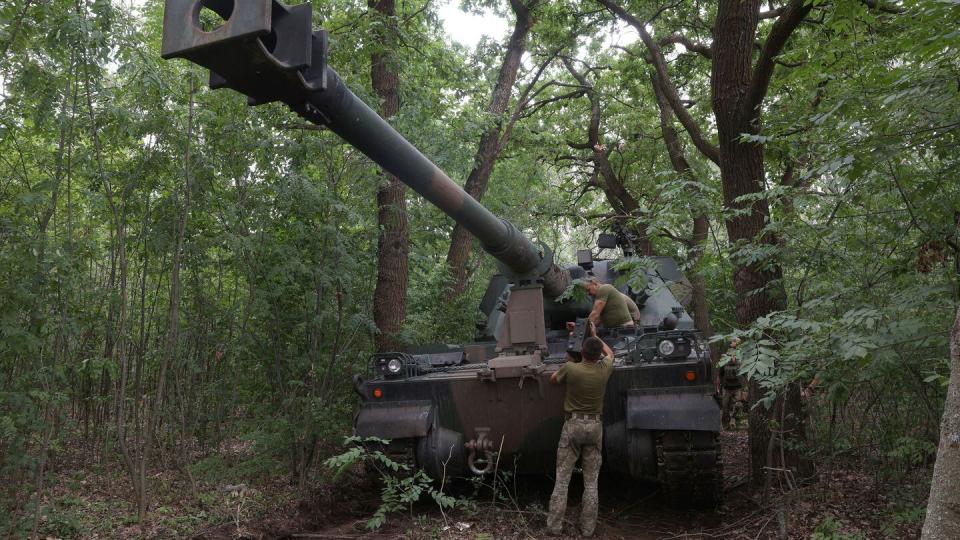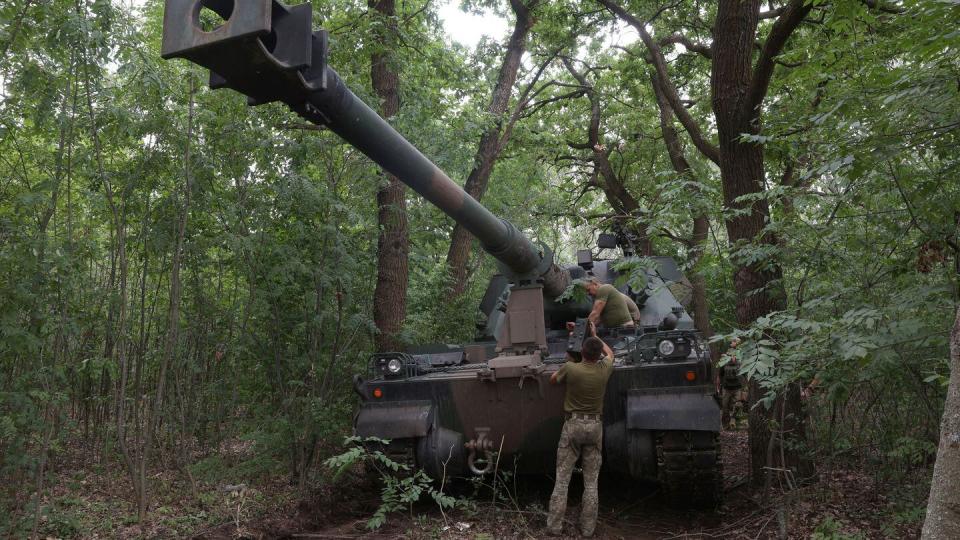As chief executive of the European Defence Agency, former Czech Defense Minister Jiří Šedivý helps shape the European Union’s voice on defense and security issues, which had begun to grow louder even before Russia’s full-scale invasion of Ukraine in 2022. Since then, the agency has slowly moved from a facilitator of collaboration among member states, with sometimes vague outcomes, to a more hands-on broker of critical military equipment urgently needed in Ukraine. He spoke with Defense News about the intricacies of designing a “menu” for 155-millimeter artillery shell purchases as well increasing cooperation between the EU and NATO, which has remained hamstrung by a long-simmering dispute involving Turkey and Cyprus.
More than two years after the beginning of Russia’s invasion, what is the appetite among member states to cooperate on defense issues?
It’s been accelerated and boosted, that’s for sure. We see it in in practice in a lot of activities, aiming first of all at supporting Ukraine, but also at replenishing, reinforcing their own national stocks.
The defense ministers in November of last year approved a new capability development plan, which is stipulating the capability development priorities, or European defense priorities. This is something which, compared to the previous iteration, which was in 2018, now is much more focused on higher-end capabilities, high-intensity operations, lessons learned or observed from Ukraine, and very much complementary with NATO. It is now being worked through what we call capability priority roadmaps, to deliver concrete capabilities across the whole spectrum of domains.
We have had very positive feedback, and this is really going to accelerate cooperation, even from the member states that used to be perhaps a bit reluctant concerning collaborative projects in the EU context.
Member states that are allies in NATO are much more socialized in NATO. But now we see, actually, that they understand that in combination with various incentives that the EU provides – joint procurement, but also for defense innovation, et cetera – that they can get higher value added from our frameworks, with our incentives, towards capabilities that are at the same time relevant for NATO.
What are those incentives?
Everything from the European Defence Fund, European Peace Facility reimbursement for equipment donated to UA, to the yet-to-be-established European Defense Industrial Program, et cetera. The incentive, in the end, is money. But it’s also economies of scale coming from getting together on collaborative programs.
The EU’s fresh designs for funding a defense resurgence, explained
There seemed to be a reflex in Europe, following Russia’s Ukraine invasion, toward national decision-making, protectionism. It sounds like you didn’t observe that, then?
When the war started, very soon our member states began to deliver military material to Ukraine, and we realized very soon that this is really a high intensity war in Europe, unprecedented since the Second World War. That it could become an attritional war for the longer term. That the volumes of consumption of military material – ammunition, in particular – are very demanding. So, the national stocks started to be depleted quite fast as member states were delivering to Ukraine. And then there were the efforts to replenish, and indeed, the initial instinct was national – to grab whatever is still on the shelves and available on the market. But then, with those incentives for joint procurement, for example, we see now a change.
Look at what we do in terms of 155 millimeter ammunition: 60 framework contracts, 10 member states actually contracting through us. Our estimate is that the volume of orders is now about €350 million, which is not bad given the current, worldwide appetite for 155mm ammunition. But at the same time, we still have a lot of spare capacities within the framework contracts that we have concluded with industry.
So, to your question, I think there was an initial reaction toward instinctive individualism. But now, as it always takes some time to develop those new frameworks and incentives, the member states actually are ready to get together more than before.

The 155 millimeter ammunition procurement mandate, is that the biggest purchasing task currently on your plate?
There are still a lot of bilateral or national activities ongoing. There is also the lead nation concept where Germany, Sweden and France offered to open their own national framework contracts for interested member states. There are activities in NATO, NSPA et cetera. It’s important to note that we are just one piece of the mosaic.
Joint procurement, per se, is not our core task at EDA. We are not procurement agents. We don’t have a dedicated directorate for doing procurement. So when we were approached by the member state to carry one track of the European Union’s 155mm ammunition initiative, we had to reshuffle a bit internally to be able to deliver. I asked member states several times to reinforce us, at least in terms of a temporary deployment of experts, without success.
In the end, we managed to deliver those framework contracts with industry – issuing requests for information, addressing the relevant industrial actors. It covers four types howitzers. You have the French Caesar, Polish Krab, Slovak Zuzana and German Panzerhaubitze 2000. There is not a ‘one-size-fits-all’ solution.
And within those, you have two types of projectiles: longer range and higher explosive. Plus, there are four components, as few producers are able to deliver complete, all-up rounds.
If you put all this together, you have a matrix of 36 slots. And for those, we have concluded those 60 framework contracts. And all this is done with around 12 people.
It’s a bit like member states getting a menu where you have starters, main courses, etc, complete with prices, delivery times and all that. Member states have all this. And it’s on them now to pick up those framework contracts and use them.
Have member states done that sufficiently?
There are spare capacities. Our framework contracts were based on an initial request for information and still have the potential to contract for up to €1 billion worth of 155mm ammunition. And we’re not talking about buying off-the-shelf, we are talking about production. What we contract today would be delivered in 12 to 24 months.
We saw in May the first delivery of ammunition procured through us, based on a contract awarded last summer.
We are delivering, but in the end it’s on the member states to put the money where their mouth is.
How much does a 155mm round cost?
There is fluctuation. But it’s definitely much more than before the war started. There isn’t a unit price. It could be from €4,000 to €10,000.
And your agency has all the industry information to determine what is a fair price?
There is nothing like fair price, there is a market price.
Given there is a war in Ukraine, and companies are sensing increased, desperation-level demand, are you seeing that reflected in the market price?
There is an increase in prices, that’s for sure. The growing demand is a factor. But so is the cost of all the inputs into the chain of production, like materials, components, gunpowder, labor force, plus inflation. So, fair price … I wouldn’t go into this category. I don’t think, actually, that the industry, by and large, would be abusing the situation.
That’s where completeness of market information comes into play …
Nobody has complete information about industry capacities, about how many have been delivered already to Ukraine. Because it’s scattered. Some member states are more transparent about what they export to Ukraine, some are less transparent. And indeed, because we are in the environment of commercial competition, the producers are also a bit cautious in terms of disclosing all the costs.
It sounds like the multitude of 155mm artillery shell types complicates the effort significantly. In an ideal world, what would you like to see change?
Well, in an ideal world, we wouldn’t have a war. But the most important lessons learned from all this goes to the fact that we are far from an ideal standardization. And one thing should not be forgotten: I am sure that what is happening in Ukraine in terms of using a plethora of various systems, this is unprecedented. And now I’m speaking about all the systems, not only artillery. So this is something which has been addressed already, both in NATO and in our standardization committee, how to really accelerate the standardization leading to interchangeable commonality. This is something that we should really take seriously.
What is your view on achieving a ‘one-size-fits-all’ 155mm round? Should companies be forced to produce to that standard, or carefully nudged?
Given the mostly private ownership, you can’t force them. It might be easier for companies where states are majority owners. We see it in Russia, how easy it was for them to swap into the war economy mode. But here, with must incentivize with funds. It must start with demand, with defining flagship projects in areas that are beyond the capacity of a single member state. There’s a top-down element: making industry work together better, for example with the leverage of aggregated demand.
Where do things stand when it comes to improving the integration of EU activities in defense with those of NATO?
First of all, there is no such thing as integration with NATO. There is very limited cooperation. And the fundamental problem with EDA and NATO is that we don’t have a security arrangement that would allow us to exchange classified information. This is something that we must resolve. However, this will require political consent on both sides. And you know that at times it can be difficult for well-known political reasons. We are trying to get, as a first step, a technical arrangement between us and NATO – governing classified information. Then we will try to conclude an administrative arrangement with NATO, which would open the ways, in predefined areas, for deeper cooperation.
EMEA Tribune is not involved in this news article, it is taken from our partners and or from the News Agencies. Copyright and Credit go to the News Agencies, email news@emeatribune.com Follow our WhatsApp verified Channel





